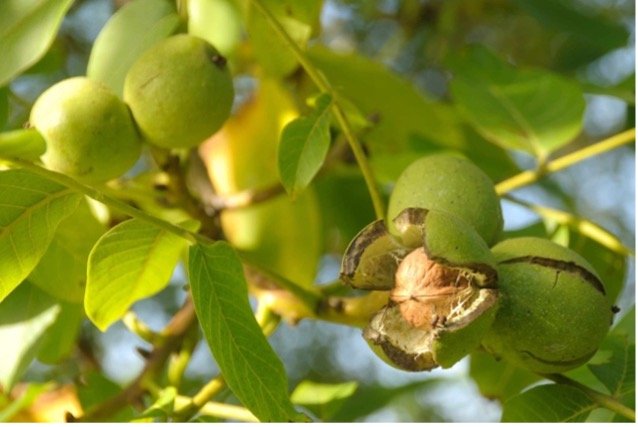
Eastern Black Walnut
Eastern Black Walnut
Botanical Name: Juglans nigraFamily Name: Juglandaceae – Walnut familyOrigin: North AmericaOur big eastern black walnut tree (Juglans nigra) is one of North America’s most valuable and beautiful natives, but it does have a “dark side.” One of the 4 black walnuts on the property is located at the back corner of the garage near the outdoor restrooms.
Early settlers found its rich-brown heartwood exceptionally resistant to decay and put it to use as fence posts, poles, shingles and sills. Its rich nuts found their way into soups, stews, pies and cakes.
Her wood is easily worked and close-grained, making prized furniture. Cabinetmakers chose it for its color and durability. Its logs are in such demand for veneer that “walnut rustlers” continue to steal trees.
In solitude, she reaches about 75 feet tall with a gracious round crown that can spread as wide as she is tall. In the forest she stretches taller, up to 150 feet. She assists the forester by performing self-pruning of her lower branches.
In the autumn, her rich nuts are a favorite of the forest animals (especially woodpeckers, foxes and squirrels). She is self-pollinating but it is helpful to have other black walnut trees to increase the production of nuts.
She is nearly impossible to transplant because her taproot runs so deep. She is also very possessive of her territory. Now comes the dark side. Her roots, leaves and fruit contain a toxic substance called “juglone.” This chemical prevents the growth of certain other plants around her, such as grasses, cabbage, tomatoes, potatoes, apples and azaleas. In this way, she protects her water supply and soil nutrients.
Her bark is long, rough and vertical. The trunk sheds lower branches making it excellent for lumber. The wood is straight and strong, a beautiful color and easily worked. At full maturity, the trunk of the black walnut can be up to 6 feet in diameter. Her leaves are large and fernlike providing light, airy shade. Her autumn leaves are bright yellow, contrasting nicely with the tree’s rugged, dark bark.
Her flowers hang side-by-side.
Medicinal Uses / Folklore
Black walnut is a known alterative, anthelmintic, antifungal, antiseptic, astringent, insecticide, laxative, and parasiticide. The green hull of the black walnut is particularly prized among contemporary herbalists; it is used to cleanse the blood and intestines and for skin conditions, including eczema, impetigo, and other kinds of dermatitis (Ritchason, 1995).
Rosemary Gladstar (2001/2008) explains that black walnut is effective against fungal infections, an action owing to its high juglone content. Interestingly, it is walnut’s juglone that makes it toxic to many other plants growing nearby.
Though they produce a bounty of edible nuts, most walnut trees are grown for their beautifully grained hardwood. Transformed into fine furniture, gunstocks, and pianos, walnut timber is a coveted resource the world over (Small, 2014).
Ways to use - edible nuts, leaves for tea, hulls for tincture.
Tincture: 5-60 drops fresh hull (1:2, 95%) or dried hull (1:5, 50%) 3x/day (Easley & Horne, 2016).
Infusion: 8 fl oz (2 tsp dried leaf in 1 cup water) (Tierra, 2003)
Decoction: 8 fl oz (1 tsp bark or hull in 1 cup water) (Tierra, 2003).
Folklore
Black walnuts were considered a good omen as far back as the Middle Ages. At weddings, the groom frequently threw black walnuts to signify his maturity. Walnuts were also used as a kind of talisman to ward off lightning, fevers, witchcraft, and epileptic seizures (Janick and Pauli, 2008).